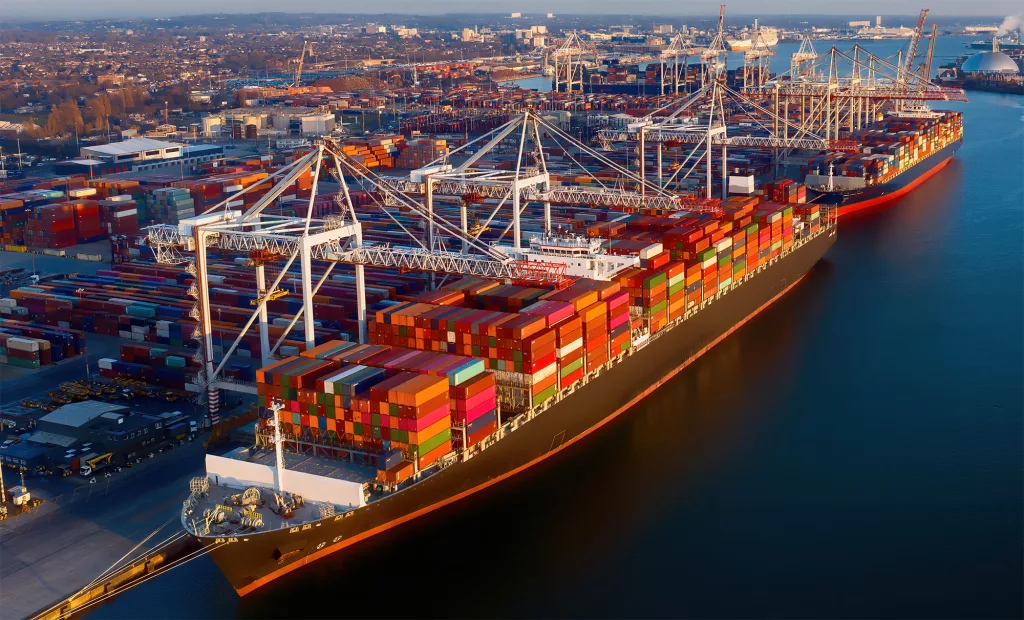Trade: Engine Room of the United Kingdom
‘While economic issues might not be centre stage by many, there is a real need for there to be a bridge-building exercise to build on trust with the European Union’, declares Lord Waverley.
Pragmatism should dictate at least listening to any outreach that the EU offers on single market access, rather than dismissing it out of hand. This might become increasingly relevant for the UK, given also the implementation plans of the EU’s strategic autonomy agenda, published in July. To put things into perspective generally, and to have an understanding of the challenges being faced by UK exporters to the EU, it would be helpful to have a relevant comparison provided by the Government to confirm, first, the trading figures for the latest calendar year of 2022 and to compare them with 2019; and, secondly, the calculated projected figures for exports to the EU for 2022 if the UK had remained in the EU. That might focus minds.

Aerial view of colorful containers on cargo ships at the port of Southampton, which is one of the Leading Port Terminal Operators in the UK.
For UK business to fully succeed with the large near neighbour already requires navigating the labyrinth of regulations and EU support programmes, so the EU’s economic security strategy is not good news for UK businesses wishing to deepen their relationship with the EU. This is compounded by the EU focus on single market integration and shift towards economic security and industrial policy, advancing with an industrial policy emerging with investment and deal-making decisions taking place in an increasingly politicised environment.
The strategy provides a comprehensive picture of the economic risks that the EU deems it faces from an increasingly challenging geopolitical environment, from supply chain resilience to economic coercion, and building on how to de-risk international supply chains in the context of rising tensions with China.
On the flip side are UK border issues, but challenges remain with UK customs border policies between the UK and EU not being aligned. Ensuring a future-ready customs infrastructure that streamlines and modernises trade and customs procedures that foster economic growth, enhances our global trade position and ensures swift and compliant cross-border trade, is paramount. Effective customs systems alignment would lead to more accurate and timely revenue collections, with streamlined and transparent processes building on stakeholder trust among traders and foreign investors.
This requires fully digitising and modernising our customs and trade procedures. Are the Government satisfied with the necessary improvement strategies in infrastructure that will enhance and facilitate transit procedures and reduce internal bottlenecks? The Government’s Ecosystem of Trust evaluation contained in the 2025 border strategy is planned to combine data and technology to move processes, where possible, away from the border. What progress is being made with the digital transformation and implementation of electronic data interchange systems to replace the outdated manual processes and development of single trade window systems, thus enabling traders to submit all documents at a single point? This would significantly improve the import process for traders and improve their border experience.
HMRC is currently engaged in two consultations with trade, one on the future of customs declarations and the other on a voluntary code of conduct for customs intermediaries, which many in the trade would like to see become mandatory. Many are questioning why HMRC is not using the existing authorised economic operator framework, which already requires applicants to demonstrate standards of competency and security. Delay to implementation of sanitary and phytosanitary checks outlined in the border target operating model is a cause of frustration and prolongs the imbalance between the regulations faced by UK food exporters. EU exporters have no such controls on sending their goods to the UK.
Many questions remain. What of the establishment of risk assessment frameworks to prioritise inspections and the development of compliance benchmarks and monitoring tools? Where are the Government on their review and recommendation for policy reforms aligned with international best practices and harmonisation with standards to boost international trade relations? Do border capacity building and training remain a challenge? Are the Government engaging with trade associations and businesses to understand and cater to their needs and, if so, what are the take- aways from such discussion?
By Lord JD Waverley
Chairman of Capital Finance International
You may have an interest in also reading…
IMF | Gulf Cooperation Council: Economic Prospects and Policy Challenges for the GCC Countries
Executive Summary The already sluggish global recovery has suffered new setbacks and uncertainty weighs heavily on prospects. The euro area
European Policy Centre on Financial Transaction Tax (FTT): Why the EU Needs the FTT but the FTT Does Not Need the EU
Background The nature of the continuing crisis in the euro area has changed several times. With the collapse of Lehman
Angela Merkel: Managing Europe’s Manifest Destiny
The job of German chancellor is not one for the faint of heart. It all boils down to leading one


















































































